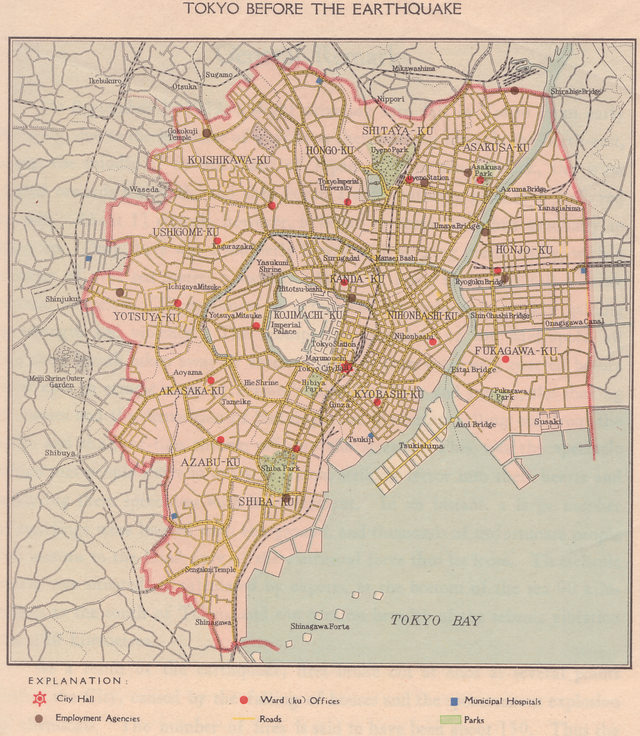Tokyo City
1889–1943 municipality in Japan From Wikipedia, the free encyclopedia
Tokyo City (東京市, Tōkyō-shi) was a municipality in Japan and capital of Tokyo Prefecture (or Tokyo-fu) which existed from 1 May 1889 until the establishment of Tokyo Metropolis on 1 July 1943.[1] The historical boundaries of Tokyo City are now occupied by the special wards of Tokyo. The defunct city and its prefecture became what is now Tokyo, also known as the Tokyo Metropolis or, ambiguously, Tokyo Prefecture.
| Tokyo City 東京市 | |||||||||
|---|---|---|---|---|---|---|---|---|---|
| City of Japan | |||||||||
| 1889–1943 | |||||||||
| History | |||||||||
• Established | 1 May 1889 | ||||||||
• Disestablished | 1 July 1943 | ||||||||
| Political subdivisions | 35 wards | ||||||||
| |||||||||



History
Summarize
Perspective
In 1868, the city of Edo, seat of the Tokugawa government, was renamed Tokyo, and the offices of Tokyo Prefecture (-fu) were opened.[1] The extent of Tokyo Prefecture was initially limited to the former Edo city, but rapidly augmented to be comparable with the present Tokyo Metropolis. In 1878, the Meiji government's reorganization of local governments[a] subdivided prefectures into counties or districts (gun, further subdivided into towns and villages, later reorganized similar to Prussian districts) and districts or wards (ku) which were in ordinary prefectures cities as a whole, e.g. today's Hiroshima City (-shi) was then Hiroshima-ku; the three major cities of Tokyo, Osaka and Kyoto were each subdivided into several such wards. In Tokyo Prefecture, this created 15 wards (listed below) and six counties/districts.[2]
In 1888, the central government created the legal framework for the current system of cities (shi)[b] that granted some basic local autonomy rights – with some similarities to Prussia's system of local self-government as Meiji government advisor Albert Mosse heavily influenced the organization of local government.[3] But under a special imperial regulation,[c] Tokyo City, like Kyoto City and Osaka City, initially did not maintain a separate mayor; instead, the (appointed) governor of Tokyo Prefecture served as mayor of Tokyo City. The Tokyo city council/assembly (Tōkyō-shikai) was first elected in May 1889.[2] Each ward also retained its own assembly. City and prefectural government were separated in 1898.,[2] and the government began to appoint a separate mayor of Tokyo City in 1898, but retained ward-level legislation, which continues to this day in the special ward system. From 1926, the mayor was elected by the elected city council/assembly from its own ranks. The city hall of Tokyo was located in the Yūrakuchō district, on a site now occupied by the Tokyo International Forum.[4]
Tokyo became the second-largest city in the world (population 4.9 million) upon absorbing several outlying districts in July 1932, giving the city a total of 35 wards.[1]
In 1943, the city was abolished along with Tokyo Prefecture to form Tokyo Metropolis and Tokyo Metropolitan Government,[1] which was functionally a part of the central government of Japan: the governor of Tokyo became a Cabinet minister reporting directly to the Prime Minister. This system remained in place until 1947 when the current structure of the Tokyo Metropolitan Government was formed.[1]
| Tōkyō-fu ("Tokyo Prefecture") | |||
| Tōkyō-shi ("Tokyo City") | Other cities (shi) | towns (machi) and villages (mura) (until 1920s subordinate to counties/districts) (island municipalities subordinate to subprefectures) | |
| Wards (ku) | |||
Wards
| 1889–1920 (15 wards) |
1920–1932 (15 wards) |
1932–1936 (35 wards) |
1936–1947 (35 wards) |
23 special wards of Tokyo Metropolis | ||
|---|---|---|---|---|---|---|
| Kōjimachi | Chiyoda | |||||
| Kanda | ||||||
| Nihonbashi | Chūō | |||||
| Kyōbashi | ||||||
| Shiba | Minato | |||||
| Azabu | ||||||
| Akasaka | ||||||
| Yotsuya | Yotsuya | Shinjuku | ||||
| Naito-Shinjuku-machi, Toyotama-gun | ||||||
| Ushigome | ||||||
| Yodobashi-machi, Toyotama-gun | Yodobashi | |||||
| Ōkubo-machi, Toyotama-gun | ||||||
| Totsuka-machi, Toyotama-gun | ||||||
| Ochiai-machi, Toyotama-gun | ||||||
| Koishikawa | Bunkyō | |||||
| Hongō | ||||||
| Shitaya | Taitō | |||||
| Asakusa | ||||||
| Honjo | Sumida | |||||
| Terashima-machi, Minami-Katsushika-gun | Mukojima | |||||
| Azuma-machi, Minami-Katsushika-gun | ||||||
| Sumida-machi, Minami-Katsushika-gun | ||||||
| Fukagawa | Kōtō | |||||
| Kameido-machi, Minami-Katsushika-gun | Jōtō | |||||
| Ōjima-machi, Minami-Katsushika-gun | ||||||
| Suna-machi, Minami-Katsushika-gun | ||||||
| Shinagawa-machi, Ebara-gun | Shinagawa | Shinagawa | ||||
| Ōi-machi, Ebara-gun | ||||||
| Ōsaki-machi, Ebara-gun | ||||||
| Ebara-machi, Ebara-gun | Ebara | |||||
| Meguro-machi, Ebara-gun | Meguro | Meguro | ||||
| Hibusuma-machi, Ebara-gun | ||||||
| Ōmori-machi, Ebara-gun | Ōmori | Ōta | ||||
| Iriarai-machi, Ebara-gun | ||||||
| Magome-machi, Ebara-gun | ||||||
| Ikegami-machi, Ebara-gun | ||||||
| Higashi-Chōfu-machi, Ebara-gun | ||||||
| Kamata-machi, Ebara-gun | Kamata | |||||
| Yaguchi-machi, Ebara-gun | ||||||
| Rokugō-machi, Ebara-gun | ||||||
| Haneda-machi, Ebara-gun | ||||||
| Setagaya-machi, Ebara-gun | Setagaya | Setagaya | Setagaya | |||
| Komazawa-machi, Ebara-gun | ||||||
| Matsuzawa-mura, Ebara-gun | ||||||
| Tamagawa-mura, Ebara-gun | ||||||
| Kinuta-mura, Kita-Tama-gun | ||||||
| Chitose-mura, Kita-Tama-gun | ||||||
| Shibuya-machi, Toyotama-gun | Shibuya | Shibuya | ||||
| Sendagaya-machi, Toyotama-gun | ||||||
| Yoyohata-machi, Toyotama-gun | ||||||
| Nakano-machi, Toyotama-gun | Nakano | Nakano | ||||
| Nogata-machi, Toyotama-gun | ||||||
| Suginami-machi, Toyotama-gun | Suginami | Suginami | ||||
| Wadabori-machi, Toyotama-gun | ||||||
| Iogi-machi, Toyotama-gun | ||||||
| Takaido-machi, Toyotama-gun | ||||||
| Sugamo-machi, Kita-Toshima-gun | Toshima | Toshima | ||||
| Nishi-Sugamo-machi, Kita-Toshima-gun | ||||||
| Nagasaki-machi, Kita-Toshima-gun | ||||||
| Takada-machi, Kita-Toshima-gun | ||||||
| Takinogawa-machi, Kita-Toshima-gun | Takinogawa | Kita | ||||
| Ōji-machi, Kita-Toshima-gun | Ōji | |||||
| Iwabuchi-machi, Kita-Toshima-gun | ||||||
| Minami-Senju-machi, Kita-Toshima-gun | Arakawa | Arakawa | ||||
| Mikawashima-machi, Kita-Toshima-gun | ||||||
| Nippori-machi, Kita-Toshima-gun | ||||||
| Ogu-machi, Kita-Toshima-gun | ||||||
| Itabashi-machi, Kita-Toshima-gun | Itabashi | Itabashi | ||||
| Kami-Itabashi-mura, Kita-Toshima-gun | ||||||
| Shimura-mura, Kita-Toshima-gun | ||||||
| Akatsuka-mura, Kita-Toshima-gun | ||||||
| Nerima-machi, Kita-Toshima-gun | Nerima | |||||
| Kami-Nerima-mura, Kita-Toshima-gun | ||||||
| Nakaarai-mura, Kita-Toshima-gun | ||||||
| Shakujii-mura, Kita-Toshima-gun | ||||||
| Ōizumi-mura, Kita-Toshima-gun | ||||||
| Senju-machi, Minami-Adachi-gun | Adachi | Adachi | ||||
| Umejima-machi, Minami-Adachi-gun | ||||||
| Nishiarai-machi, Minami-Adachi-gun | ||||||
| Kōhoku-mura, Minami-Adachi-gun | ||||||
| Toneri-mura, Minami-Adachi-gun | ||||||
| Ikō-mura, Minami-Adachi-gun | ||||||
| Fuchie-mura, Minami-Adachi-gun | ||||||
| Higashi-Fuchie-mura, Minami-Adachi-gun | ||||||
| Hanahata-mura, Minami-Adachi-gun | ||||||
| Ayase-mura, Minami-Adachi-gun | ||||||
| Honden-machi, Minami-Katsushika-gun | Katsushika | Katsushika | ||||
| Okudo-machi, Minami-Katsushika-gun | ||||||
| Minami-Ayase-machi, Minami-Katsushika-gun | ||||||
| Kameao-mura, Minami-Katsushika-gun | ||||||
| Niijuku-machi, Minami-Katsushika-gun | ||||||
| Kanamachi-machi, Minami-Katsushika-gun | ||||||
| Mizumoto-mura, Minami-Katsushika-gun | ||||||
| Komatsugawa-machi, Minami-Katsushika-gun | Edogawa | Edogawa | ||||
| Matsue-mura, Minami-Katsushika-gun | ||||||
| Mizue-mura, Minami-Katsushika-gun | ||||||
| Kasai-mura, Minami-Katsushika-gun | ||||||
| Shikamoto-mura, Minami-Katsushika-gun | ||||||
| Shinozaki-mura, Minami-Katsushika-gun | ||||||
| Koiwa-machi, Minami-Katsushika-gun | ||||||
See also
Notes
- The 郡区町村編制法 gun-ku-chō-son hensei-hō, of 1878, the law on the organization of gun (counties/districts), ku (cities/districts/wards), towns and villages, one of the "three new laws" on local government of 1878 that also created prefectural taxation rights and prefectural assemblies (地方三新法, chihō san-shinpō, 地方三新法)
References
Further reading
External links
Wikiwand - on
Seamless Wikipedia browsing. On steroids.









